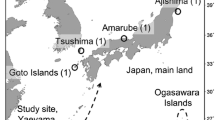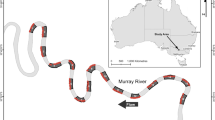Abstract
Sex- and age-class-specific survival probabilities of a southern Great Barrier Reef green sea turtle population were estimated using a capture–mark–recapture (CMR) study and a Cormack–Jolly–Seber (CJS) modelling approach. The CMR history profiles for 954 individual turtles tagged over a 9-year period (1984–1992) were classified into three age classes (adult, subadult, juvenile) based on somatic growth and reproductive traits. Reduced-parameter CJS models, accounting for constant survival and time-specific recapture, fitted best for all age classes. There were no significant sex-specific differences in either survival or recapture probabilities for any age class. Mean annual adult survival was estimated at 0.9482 (95% CI: 0.92–0.98) and was significantly higher than survival for either subadults or juveniles. Mean annual subadult survival was 0.8474 (95% CI: 0.79–0.91), which was not significantly different from mean annual juvenile survival estimated at 0.8804 (95% CI: 0.84–0.93). The time-specific adult recapture probabilities were a function of sampling effort but this was not the case for either juveniles or subadults. The sampling effort effect was accounted for explicitly in the estimation of adult survival and recapture probabilities. These are the first comprehensive sex- and age-class-specific survival and recapture probability estimates for a green sea turtle population derived from a long-term CMR program.
Similar content being viewed by others
References
Aebischer NJ, Coulson JC (1990) Survival of the Kittiwake in relation to sex, year, breeding experience and position in colony. J Anim Ecol 59:1063–1071
Anderson DR, Wywialowski AP, Burnham KP (1981) Tests of the assumptions underlying life table methods for estimating parameters from cohort data. Ecology 62:1121–1124
Anderson DR, Burnham KP, White GC (1994) AIC model selection in overdispersed capture-recapture data. Ecology 75:1780–1793
Bjorndal KA, Bolten AB, Chaloupka MY (2003) Survival probability estimates for immature green turtles Chelonia mydas in the Bahamas. Mar Ecol Prog Ser 252:273–281
Brownie C, Hines JE, Nichols JD, Pollock KH, Hestbeck JB (1993) Capture-recapture studies for multiple strata including non-Markovian transitions. Biometrics 49:1173–1187
Burgman MA, Ferson S, Akcakaya HR (1993) Risk assessment in conservation biology. Chapman and Hall, New York
Burnham KP, Anderson DR, White GC, Brownie C, Pollock KH (1987) Design and analysis methods for fish survival experiments based on release-recapture. Am Fish Soc Monogr 5:1–437
Chaloupka M (2002) Stochastic simulation modelling of southern Great Barrier Reef green turtle population dynamics. Ecol Model 148:79–109
Chaloupka MY, Limpus CJ (1998) Modelling green sea turtle survivorship rates. In: Epperly SP, Braun J (eds) Proceedings of the seventeenth annual symposium on sea turtle biology and conservation. NOAA Tech Memo NMFS-SEFSC-415:24–26
Chaloupka MY, Limpus CJ (2001) Trends in the abundance of sea turtles resident in southern Great Barrier Reef waters. Biol Conserv 102:235–249
Chaloupka M, Limpus CJ (2002) Survival probability estimates for the endangered loggerhead sea turtle resident in southern Great Barrier Reef waters. Mar Biol 140:267–277
Chaloupka MY, Musick JA (1997) Age, growth and population dynamics. In: Lutz PJ, Musick JA (eds) The biology of sea turtles. (CRC Marine Science Series) CRC Press, Boca Raton, Fla., pp 233–276
Chaloupka M, Osmond M, Kaufman G (1999) Estimating seasonal abundance trends and survival probabilities of humpback whales in Hervey Bay (east coast Australia). Mar Ecol Prog Ser 184:291–301
Chaloupka M, Limpus C, Miller J (2004) Green turtle somatic growth dynamics in a spatially disjunct Great Barrier Reef metapopulation. Coral Reefs 23:325–335
Charlesworth B (1980) Evolution in age-structured populations. Cambridge University Press, Cambridge
Clinton WL, Le Boeuf BJ (1993) Sexual selection’s effects on male life history and patterns of male mortality. Ecology 74:1884–1892
Cooch E, Pradel R, Nur N (1996) A practical guide to mark-recapture analysis using SURGE. Centre d’Ecologie Fonctionelle et Evolutive—CNRS, Montpellier, France
Cormack RM (1989) Log-linear models for capture-recapture. Biometrics 45:395–413
Cormack RM (1993) The flexibility of GLIM analyses of multiple recapture or resighting data. In: Lebreton J-D, North PM (eds) Marked individuals in the study of bird populations. Birkhauser, Basel, pp 39–49
Flatt T, Dummermuth S, Anholt BR (1997) Mark-recapture estimates of survival in populations of the asp viper, Vipera aspis aspis. J Herpetol 31:558–564
Fox GA (1993) Life history evolution and demographic stochasticity. Evol Ecol 7:1–14
Gaillard JM, Delorme D, Boutin JM, Van Laere G, Boisaubert B, Pradel R (1993) Roe deer survival patterns: a comparative analysis of contrasting populations. J Anim Ecol 62:778–791
Gaillard JM, Festa-Bianchet M, Yoccoz NG (1998) Population dynamics of large herbivores: variable recruitment with constant adult survival. Trends Ecol Evol 13:58–63
Gibbons JW, Semlitsch RD (1982) Survivorship and longevity of a long-lived vertebrate species: how long do turtles live? J Anim Ecol 51:523–527
Gould WR, Nichols JD (1998) Estimation of temporal variability of survival in animal populations. Ecology 79:2531–2538
Harris MP, Buckland ST, Russell SM, Wanless S (1994) Year- and age-related variation in the survival of adult European shags over a 24-year period. Condor 96:600–605
Hastings KK, Testa JW, Rexstad EA (1999) Interannual variation in survival of juvenile Weddell seals (Leptonychotes weddellii) from McMurdo Sound, Antarctica: effects of cohort, sex and age. J Zool 248:307–323
Jorgensen JT, Festa-Bianchet M, Gaillard JM, Wishart WD (1997) Effects of age, sex, disease, and density on survival of bighorn sheep. Ecology 78:1019–1032
Kendall WL, Nichols JD, Hines JE (1997) Estimating temporary emigration using capture-recapture data with Pollock’s robust design. Ecology 78:563–578
Langtimm CA, O’Shea TJ, Pradel R, Beck CA (1998) Estimates of annual survival probabilities for adult Florida manatees (Trichechus manatus latirostris). Ecology 79:981–997
Lawless JF (1982) Statistical models and methods for lifetime data. Wiley, New York
Lebreton JD, Burnham KP, Clobert J, Anderson DR (1992) Modeling survival and testing biological hypotheses using marked animals: a unified approach with case studies. Ecol Monogr 62:67–118
Limpus CJ (1992) Estimation of tag loss in marine turtle research. Wildl Res 19:457–469
Limpus CJ (1993) The green turtle, Chelonia mydas, in Queensland: breeding males in the southern Great Barrier Reef. Wildl Res 20:513–523
Limpus CJ, Nicholls N (1994) Progress report on the study of the interaction of the El Nino—Southern Oscillation on annual Chelonia mydas at the southern Great Barrier Reef rookeries. In: James R (ed) Proceedings of the marine turtle conservation workshop. Australian National Parks and Wildlife Service, Canberra, Australia, pp 73–78
Limpus CJ, Reed PC (1985) The green turtle, Chelonia mydas, in Queensland: a preliminary description of the population structure in a coral reef feeding ground. In: Grigg G, Shine R, Ehmann H (eds) Biology of Australasian frogs and reptiles. Royal Society of New South Wales, Sydney, Australia, pp 47–52
Limpus CJ, Miller JD, Parmenter CJ, Reimer D, McLachlan N, Webb R (1992) Migration of green (Chelonia mydas) and loggerhead (Caretta caretta) turtles to and from eastern Australian rookeries. Wildl Res 19:347–358
Limpus CJ, Couper PJ, Read MA (1994) The green turtle, Chelonia mydas, in Queensland: population structure in a warm temperate feeding area. Mem Queensl Mus 35:139–154
Link WA, Nichols JD (1994) On the importance of sampling variance to investigations of temporal variation in animal population size. Oikos 69:539–544
McNamara JM, Houston AI (1996) State-dependent life histories. Nature 380:215–221
Musick JA, Limpus CJ (1997) Habitat utilization and migration in juvenile sea turtles. In: Lutz PL, Musick JA (eds) The biology of sea turtles. (CRC Marine Science Series) CRC Press Inc, Boca Raton, Fla., pp 137–163
National Research Council (1990) Decline of sea turtles: causes and prevention. National Academy Press, Washington D.C.
Nichols JD, Pollock KH (1983) Estimation methodology in contemporary small mammal capture-recapture studies. J Mammal 64: 253–260
Nichols JD, Hines JE, Blums P (1997) Tests for senescent decline in annual survival probabilities of common pochards, Aythya ferina. Ecology 78:1009–1018
Paradis E, Guedon G, Pradel R (1993) Estimation of sex- and age-related survival rates in a microtine population. J Wildl Manage 57:158–163
Pollock KH, Nichols JD, Brownie C, Hines JE (1990) Statistical inference for capture-recapture experiments. Wildl Monogr 107:1–97
Pradel R (1993) Flexibility in survival analysis from recapture data: handling trap-dependence. In: Lebreton J-D, North PM (eds) Marked individuals in the study of bird populations. Birkhauser, Basel, pp 29–37
Pradel R, Reboulet AM, Viallefont A (1995) Testing hypotheses and estimating survival from capture histories with CR. J Appl Stat 22:775–784
Pradel R, Hines JE, Lebreton J-D, Nichols JD (1997) Capture-recapture survival models taking account of transients. Biometrics 53:88–99
Pugesek BH, Nations C, Diem KL, Pradel R (1995) Mark-resighting analysis of a California gull population. J Appl Stat 22:625–639
Ringsby TH, Saether BE, Altwegg R, Solberg EJ (1999) Temporal and spatial variation in survival rates of a house sparrow, Passer domesticus, metapopulation. Oikos 85:419–425
Sauer JR, Williams BK (1989) Generalized procedures for testing hypotheses about survival or recovery rates. J Wildl Manage 53:137–142
Seber GAF (1982) The estimation of animal abundance and related parameters, 2nd edn. Griffin, London
Shine R, Charnov EL (1992) Patterns of survival, growth and maturation in snakes and lizards. Am Nat 139:1257–1269
Shine R, Iverson JB (1995) Patterns of survival, growth and maturation in turtles. Oikos 72:343–348
Slater J, Limpus C, Robins J, Pantus F, Chaloupka M (1998) Risk assessment of sea turtle capture in the Queensland east coast otter trawl fishery. Report prepared for TRAWLMAC, Queensland Fish Management Authority on behalf of the Great Barrier Reef Marine Park Authority and the Queensland Departments of Environment and Primary Industries. Queensland Department of Environment, Brisbane, Australia
Spendelow JA, Nichols JD, Nisbet IC, Hays H, Cormons GD, Burger J, Safina C, Hines JE, Gochfield M (1995) Estimating annual survival and movement rates of adults within a metapopulation of roseate terns. Ecology 76:2415–2428
White GC, Burnham KP (1999) Program MARK: survival estimation from populations of marked animals. Bird Study 46 (Suppl):120–138
Zug GR, Balazs GH, Wetherall JA, Parker DM, Murakawa SKK (2002) Age and growth in Hawaiian green seaturtles (Chelonia mydas): an analysis based on skeletochronology. Fish Bull 100:117–127
Acknowledgements
This work was funded in part by grants from the Australian Nature Conservation Agency, Australian Department of Science (Marine Science and Technology), and the Great Barrier Reef Marine Park Authority. Field assistance was provided by S. Allen, D. Walter, A. Fleay, P. Reed, E. Gyuris, D. Reimer, and numerous volunteer assistants. We thank R. Cormack for providing GLIM code and statistical advise on capture–recapture modelling. We also thank G. Balazs, K. Bjorndal, A. Bolten, G. Grigg, and J. Parmenter for helpful comments on the manuscript.
Author information
Authors and Affiliations
Corresponding author
Additional information
Communicated by M.S. Johnson, Crawley
Rights and permissions
About this article
Cite this article
Chaloupka, M., Limpus, C. Estimates of sex- and age-class-specific survival probabilities for a southern Great Barrier Reef green sea turtle population. Marine Biology 146, 1251–1261 (2005). https://doi.org/10.1007/s00227-004-1512-6
Received:
Accepted:
Published:
Issue Date:
DOI: https://doi.org/10.1007/s00227-004-1512-6




